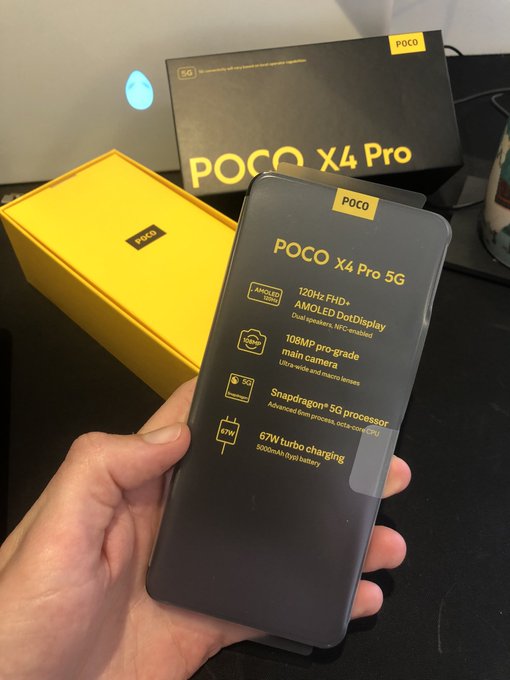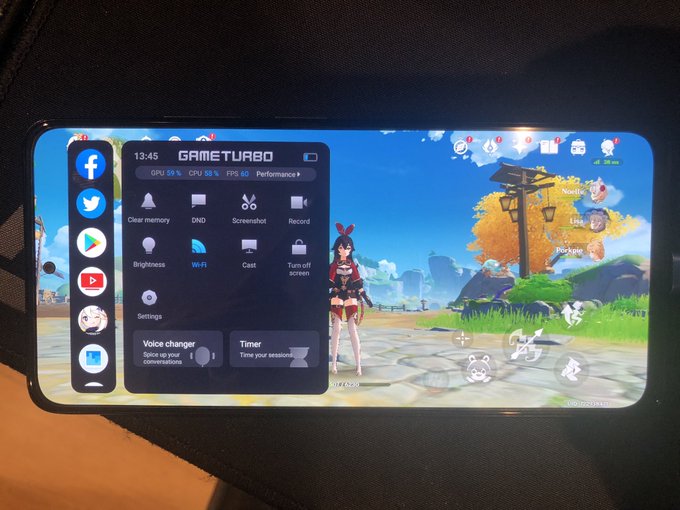Daily Driving The Xiaomi POCO X4 Pro
It’s no secret that I’m a die-hard iPhone user. I know the tradeoffs and decided I prefer a more appliance-like experience for something that – let’s face it – is an extension of my arm. But I got the chance to try a low mid-range Android phone – the POCO X4 Pro – and I don’t hate it. In fact the POCO feels refreshingly open, like the Windows mobile phones I was using a decade or two ago. As a consequence it makes my iPhone X feel like my first iPhone – the 3GS. It takes me back to those first tentative days switching from what was probably a wide open Nokia N900 (Maemo) or HTC TYTN 2 (Windows Mobile) to something wholly different. It’s a weird sensation, picking up my iPhone X and really feeling its age, but is this revelation enough for me to cast off the iOS shackles in favour of the Android wild west? In short: no. Let’s explore why.
Viddy you on that gloopy tweet hole
First off; a bit of back story. I’m a tinkerer and programmer both professionally and by nature. I’m easily drawn into losing hours tweaking, prodding and poking something new. I love exploring these rabbit holes, but I’m very mindful that they eat up my free time. As such the attraction of iPhone and iOS (and indeed also macOS back before the touch bar debacle put me off Mac’s for four or so years) is the very thing that typical technical Android users very vocally hate. The golden handcuffs.
It’s not that I don’t like to tinker, but rather I don’t want the device I use for recreational Twitter shenanigans to be prone to vanishing hours of my time with distractions.
Of course this means that I absolutely reveled in tweaking the POCO to the nth degree. At least insofar as someone largely unfamiliar with Android (TVs, projectors and Retroid Pocket 2 notwithstanding) could.
The POCO X4 Pro is a fairly respectable bit of hardware for the price. It’s got a 120Hz OLED screen, checking a very crucial box right out of the gate. The pixel density is noticeably lower than that of my iPhone but it isn’t painfully so. The camera makes a lot of bold claims – it seems Android phones are never sure enough in their features not to have “108MP” and “AI” silk-screened all over the phone – but doesn’t seem to perform much better than that of my iPhone. It’s also pre-configured for the Asian market and – by default – applied a rather distressing soft filter to my face.
The use of a USB Type-C connector- something that Android users take for granted and iPhone users just have to pretend they don’t want – means my USB Type-C YubiKey works right out of the box. Excellent!
The POCO X4 Pro comes preinstalled with a fairly comprehensive attempt to bring some consistency and a solid user experience: MIUI. This comprises a launcher and a suite of apps to handle common tasks: file explorer, video player, calculator, gallery and so on.
MIUI is fairly decent and the tight integration between apps makes for a familiar feeling experience. Where it falls short- however- is the same curse that befalls cheap Windows laptops: it’s absolutely riddled with adware and many of the apps feel a little like spyware.
Ads in preinstalled Apps came as a bit of a culture shock. I’m told this isn’t commonplace in Android, but seeing an ad inline with my downloaded video files was absolutely astonishing to me. The saving grace is that anyone experienced with Android’s debug menu and “ADB” can nuke the offending apps from orbit, replacing them with their choice of alternatives. But for those who aren’t? If you’re picking up a cheap Android phone be aware that you might be paying for it with your usage habits or your attention.
A consequence of this is that Xiaomi’s preinstalled apps are prone to launching in-your-face privacy policies. While it’s pointed out quite reasonably to me that Apple’s individual apps are also subject to a privacy policy it remains weird that even the calculator on POCO wanted my agreement before it would let me add numbers. Similarly the “security” app, which in practice acts as a shortcut to some useful device settings, also prompts for agreement. Though in its case it doesn’t require that you agree in order for the app to launch. This is a relief since uninstalling Security or any of its components via ADB leads to a boot loop. Ouch!
These privacy concerns and the mere sniff of adverts in apps make it difficult for me to recommend this phone to the average user. Or perhaps it makes it difficult for me to confront the reality that the average user doesn’t really care. However you slice it, the POCO X4 Pro is a heck of a lot of phone for the price and it seems only reasonable that there should be caveats. What’s unforgivable is that these aren’t mentioned in the marketing or on the box. At least when Amazon sold an Ad-supported Kindle it was clearly marketed as such. While I’d prefer no advertising I’d be willing to concede disclosed advertising as a fair middle ground. I don’t believe this would adversely affect sales quite so much as I want to believe it would.
Moving swiftly on- with many of the preinstalled apps nuked via ADB the MIUI experience started to crumble somewhat. While the swipe gestures were great, other benefits – such as the clock with a weather summary – wouldn’t work without their counterpart apps. I ended up swapping the MIUI POCO launcher for Nova 7. It’s pretty good. Another few hours were spent tweaking it to my personal pinnacle of perfection.
And that’s the real crux of the Android experience- don’t like it? Hit Twitter and you’ll get a recommendation for something else. I replaced the video player with the far superior (excellent in fact) VLC media player, I replaced the file browser with the free and open source Amaze from f-droid, I replaced Clock and Calculator (begrudgingly since Xiaomi’s apps are actually pretty decent) with Google’s stock ones, and the gallery with at least three different apps because I couldn’t pick one.
What’s more- I could install YouTube Vanced, despite it being vanished due to legal issues, a BitTorrent client, and the Nintendo DS emulator I bought for but ended up not using on my Retroid Pocket 2+. I must attest to be quite pleased with this temporary respite from the obnoxious and overtly frequent ads that have made YouTube all but unwatchable lately
Outside of the common suite of apps I had to discover alternatives to Reddit (for Elden Ring and Steam Deck news) and Hacker News (which I continue to subject myself to). Infinity and Glider respectively proved to be very solid choices.
Conversely, Twitter, my mainstay, is worse on Android. The app hides the “Home” button when viewing tweets, resulting in multiple taps of “back” required to return to my timeline. It also forces Twitter’s more esoteric post features with a Tweet menu instead of launching straight to a text tweet. Finally text selection never seems to quite work reliably making editing what I’ve just typed a chore. Again the inconsistency and lack of UX direction that plagues Android in general seems to be the cause here. As such muscle memory has to be deeply contextual and even after multiple days of use I’m struggling to get the same fluid, first nature experience on Android that I feel as soon as I pick my iPhone back up.
And yet the POCO X4 Pro is growing on me. I can’t help but return to the invasive thought: this is a £299 phone and it feels incredible. Over the four years I’ve owned my iPhone X I could – for roughly the same price – have updated a fairly decent mid range Android phone three whole times. This isn’t news to me, but I think it’s important to recognise the premium I’m paying for a cohesive and controlled yet drip-fed and very limiting experience. But this recognition doesn’t turn me off Apple’s offering so much as make me wonder if I shouldn’t grab a budget Android phone to serve as a counterpart. A device I can use for entertainment and tinkering, perhaps even while keeping my iPhone to hand to – as is the custom for a very easily distracted geek like me – chat on Discord while I semi-watch a movie or a YouTube deep dive into Mario 64 speedrunning technique.
And good grief is the POCO X4 Pro a wonderful media device for the money. While the CPU downgrade from the X3 makes it mediocre to acceptable at best for gaming and emulation the large, bright AMOLED and punchy speakers make it a fantastic little thing for propping up and watching a film. And it’ll do so for hours, too, with a battery that’ll last me two days (albeit not inserting a SIM and using only WiFi probably has a lot to do with this.)
A modern, budget Android phone embodies everything that Archos (remember those?!) Portable media players used to be. Except the Android device is better in, insofar as I can remember those ill-fated and often pretty janky devices, every conceivable way. iPhones? Close, but the pain of side-loading media and lack of SD card support for expansion make them only really tenable as streaming devices (and I say this as someone with a bunch of – Ghibli-style TV advertisements if you just know – video files saved into VLC on my iPhone).
Overall I’m pretty impressed with the POCO. It seems smooth enough, has a decent battery life and I’ve found it quite useful. Heck it’s still getting daily use after three weeks. Would I recommend it? Well… sort-of… with the enormous caveat that undisclosed ads baked into the software should be cause for alarm. Oh, and the second enormous caveat that the POCO X3 has significantly better GPU/CPU performance- making the X4 considerably worse for mobile gaming. It’s only fitting that I should find myself with an odd duck of an Android phone as the first one I have tried since… well I suppose the Planetcom Gemini or … the Motorola Defy!? It certainly counts in the X4’s favour that I find it… perfectly acceptable. Good enough to cast off my iPhone shackles? No. But an excellent, open and flexible complement.




